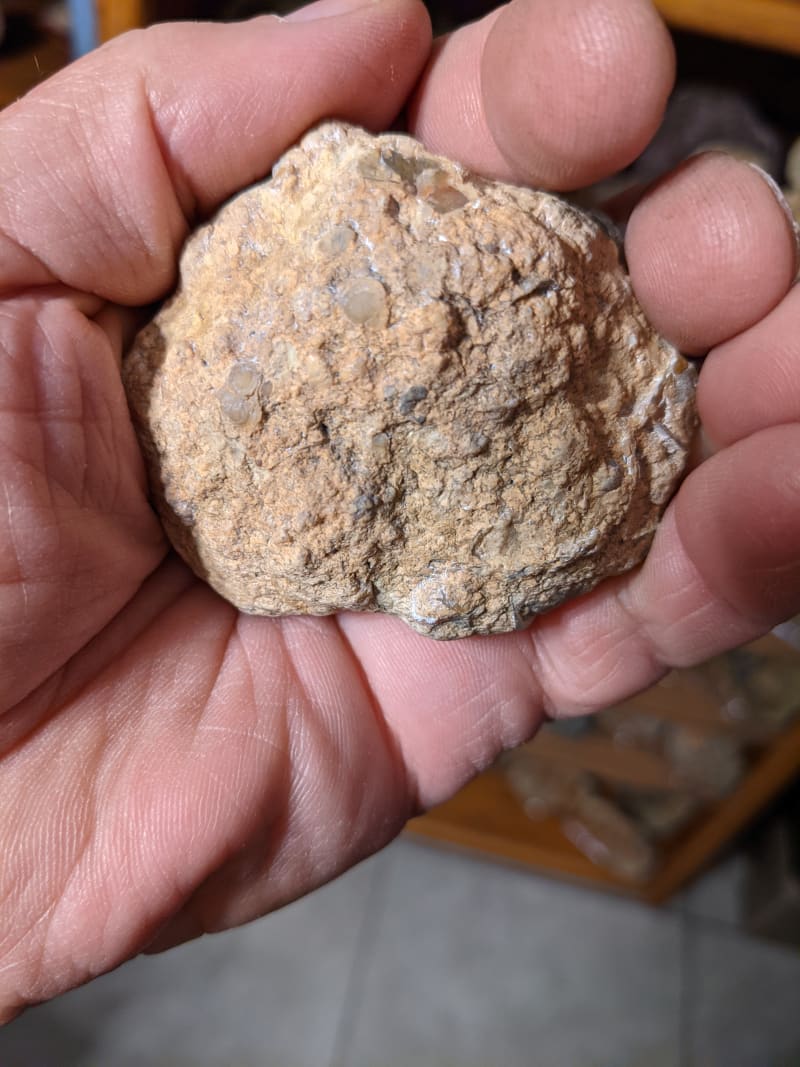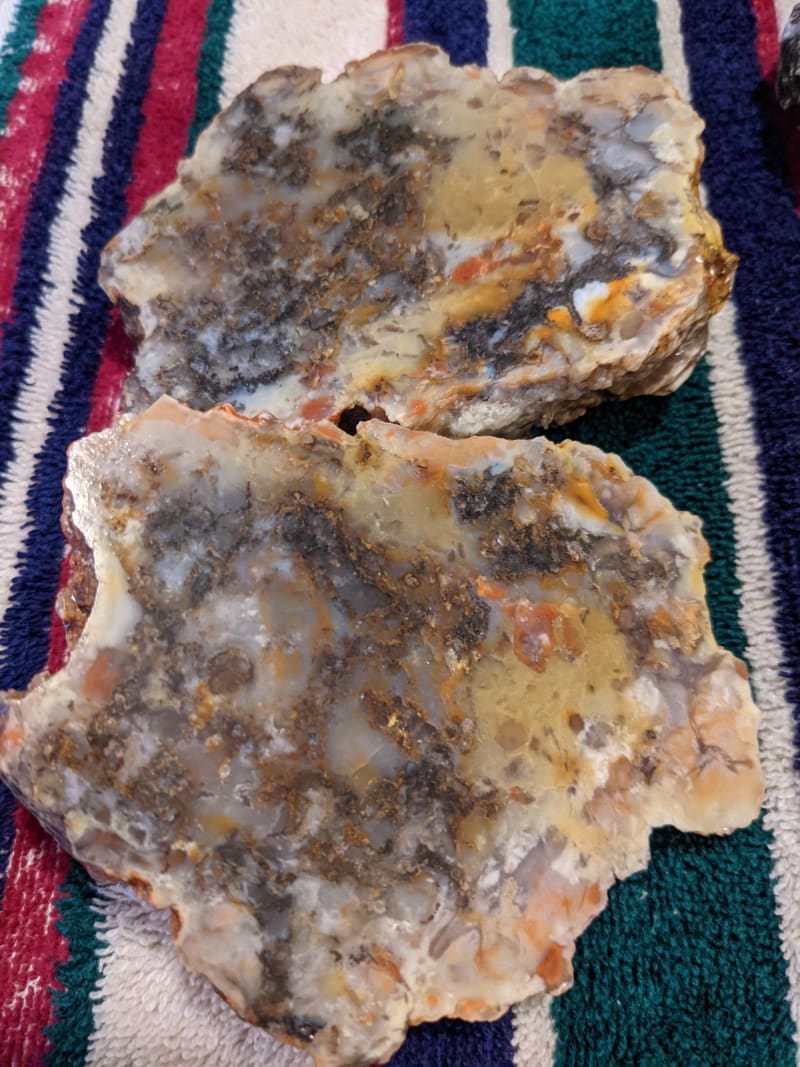RWA3006
Cave Dweller 
Member since March 2009
Posts: 4,612 
|
Post by RWA3006 on Feb 9, 2021 20:34:28 GMT -5
I imagine the diet of horsetails, pines, ferns, cycads and perhaps algae required large quantities in conjunction with an inefficient digestive tract which must have produced huge quantities of poo. The quantity could have been reduced if the critters had some kind of a rumen that would redigest the material but I have no idea if such anatomy had evolved by then.
It seems counter intuitive to combine a rumen with gastroliths, but it could be a possibility. It's a common practice to get a cow to swallow a powerful magnet that stays in the rumen for the purpose of attracting metallic objects like wire in order to prevent them from passing through and doing damage along the way.
|
|
RWA3006
Cave Dweller 
Member since March 2009
Posts: 4,612 
|
Post by RWA3006 on Feb 10, 2021 21:42:57 GMT -5
Did you ever see such an ugly, plain leaverite?  |
|
RWA3006
Cave Dweller 
Member since March 2009
Posts: 4,612 
|
Post by RWA3006 on Feb 10, 2021 21:46:22 GMT -5
Here's the same one cut in half and polished. Goes to show you never know for sure what's in a coprolite till you cut it open.  Coprolites are like chocolates. You never know what's inside. |
|
RWA3006
Cave Dweller 
Member since March 2009
Posts: 4,612 
|
Post by RWA3006 on Feb 10, 2021 22:16:44 GMT -5
Anyone see the weasels facing each other in the halves above?
|
|
|
|
Post by jasoninsd on Feb 10, 2021 22:22:15 GMT -5
Anyone see the weasels facing each other in the halves above? It took me a minute. But I see it. To me, they appear to be glaring at each other with "squinty" eyes! |
|
|
|
Post by RickB on Feb 11, 2021 7:07:09 GMT -5
Fresh coprolites look like chocolate brown. Finding Dory? I see a large blue/gray fish outline in there.
|
|
stewdogg
spending too much on rocks
 
Member since January 2020
Posts: 388
|
Post by stewdogg on Feb 11, 2021 10:22:40 GMT -5
Here's the same one cut in half and polished. Goes to show you never know for sure what's in a coprolite till you cut it open. Hello RWA3006, how do you go about polishing the flats on that sweet lookin poo? I imagine you have the correct tool and you don't do it by hand? I need to put some work in on the specimens I have (thank you Randy), so I can add some pics to this thread because it's going to be a while before I get anything finished out of the tumbler. That and the tile saw is in hibernation till the warmer weather gets here. |
|
RWA3006
Cave Dweller 
Member since March 2009
Posts: 4,612 
|
Post by RWA3006 on Feb 11, 2021 11:07:53 GMT -5
Here's the same one cut in half and polished. Goes to show you never know for sure what's in a coprolite till you cut it open. Hello RWA3006, how do you go about polishing the flats on that sweet lookin poo? I imagine you have the correct tool and you don't do it by hand? I need to put some work in on the specimens I have (thank you Randy), so I can add some pics to this thread because it's going to be a while before I get anything finished out of the tumbler. That and the tile saw is in hibernation till the warmer weather gets here. A flat lap, bull wheel, or Richardson's polisher would work well. Use the same process as if it were a thunder egg. A well tuned saw with a sharp blade helps make a clean cut which helps also. |
|
|
|
Post by RickB on Feb 11, 2021 12:18:51 GMT -5
Thunder Egg  Now that's funny. |
|
RWA3006
Cave Dweller 
Member since March 2009
Posts: 4,612 
|
Post by RWA3006 on Feb 11, 2021 13:14:28 GMT -5
Thunder Egg  Now that's funny. Some of the biggest specimens I've found are bushel basket size and they just might have thundered when they hit the ground. At least a hollow thud anyway. |
|
stewdogg
spending too much on rocks
 
Member since January 2020
Posts: 388
|
Post by stewdogg on Feb 11, 2021 13:15:37 GMT -5
A flat lap, bull wheel, or Richardson's polisher would work well. Use the same process as if it were a thunder egg. A well tuned saw with a sharp blade helps make a clean cut which helps also. Hmmm, I do have a spare 1/2hp motor laying around. Maybe I should make a flat lap... I will have to look into the two others you listed as I've never heard of them. Thanks for the info, rocks and beautiful pics!! |
|
Brian
fully equipped rock polisher
  
Member since July 2020
Posts: 1,512
|
Post by Brian on Feb 12, 2021 12:08:56 GMT -5
This place is probably as good as any to drop this little nugget, since it is at least somewhat relevant to this crappy topic. Or at least my earlier ruminations on the quantities of poo produced. According to researchers in Australia, sea cucumbers on the Great Barrier Reef in just the portion surrounding Heron Island deposit 64,000 metric tons of poo each year. Each little sea cucumber makes a deposit of about 38 grams a day. The poo contributes to bioturbation that releases nutrients from sediment to the ecosystem. If little sea cucumber poop has such an impact on their ecosystem, it makes you wonder how dino poop impacted their environment as well. Considering the length of the age of dinosaurs, the more appropriate question may actually be how dinosaur poop impacted our environment today. Here is a link to an article on the research. |
|
RWA3006
Cave Dweller 
Member since March 2009
Posts: 4,612 
|
Post by RWA3006 on Feb 13, 2021 10:20:48 GMT -5
I've been getting a few questions about what is the best way to cut a coprolite for specimen purposes. I usually like to bisect them like the way you cut a bagel.  |
|
RWA3006
Cave Dweller 
Member since March 2009
Posts: 4,612 
|
Post by RWA3006 on Feb 13, 2021 10:21:41 GMT -5
|
|
RWA3006
Cave Dweller 
Member since March 2009
Posts: 4,612 
|
Post by RWA3006 on Feb 13, 2021 10:22:26 GMT -5
|
|
RWA3006
Cave Dweller 
Member since March 2009
Posts: 4,612 
|
Post by RWA3006 on Feb 13, 2021 10:25:14 GMT -5
I often find myself selecting flying saucer shaped coprolites for specimens, while using the more blocky chunks for cutting rough. Just seems to work better that way.
|
|
Brian
fully equipped rock polisher
  
Member since July 2020
Posts: 1,512
|
Post by Brian on Feb 13, 2021 10:52:29 GMT -5
I've been getting a few questions about what is the best way to cut a coprolite for specimen purposes. I usually like to bisect them like the way you cut a bagel.  That one looks like an everything bagel! Do you notice much difference in the interiors between the flatter ones vs the more rounded ones? |
|
|
|
Post by RickB on Feb 13, 2021 11:33:51 GMT -5
This place is probably as good as any to drop this little nugget, since it is at least somewhat relevant to this crappy topic. Or at least my earlier ruminations on the quantities of poo produced. According to researchers in Australia, sea cucumbers on the Great Barrier Reef in just the portion surrounding Heron Island deposit 64,000 metric tons of poo each year. Each little sea cucumber makes a deposit of about 38 grams a day. The poo contributes to bioturbation that releases nutrients from sediment to the ecosystem. If little sea cucumber poop has such an impact on their ecosystem, it makes you wonder how dino poop impacted their environment as well. Considering the length of the age of dinosaurs, the more appropriate question may actually be how dinosaur poop impacted our environment today. Here is a link to an article on the research. Dino poo definitely is impacting our environment. RWA3006 is literally tripping over this stuff, gets it on his shoes every time he goes rockhounding. |
|
RWA3006
Cave Dweller 
Member since March 2009
Posts: 4,612 
|
Post by RWA3006 on Feb 13, 2021 14:06:43 GMT -5
I've been getting a few questions about what is the best way to cut a coprolite for specimen purposes. I usually like to bisect them like the way you cut a bagel.  That one looks like an everything bagel! Do you notice much difference in the interiors between the flatter ones vs the more rounded ones? I think I can't discern as much difference between shapes as I can sizes. I've noticed the most vibrant colors and patterns tend to occur in specimens smaller than a cantaloupe. Any bigger and they seem to be more amorphous on average. Prominent agate veins running through them seems to stack the odds in favor of awesomeness too. These veins are often prominent on the outer surfaces because they weather slower than the rest of the stone. Let me see if I can find a good example ... stay tuned. |
|
RWA3006
Cave Dweller 
Member since March 2009
Posts: 4,612 
|
Post by RWA3006 on Feb 13, 2021 14:07:42 GMT -5
|
|